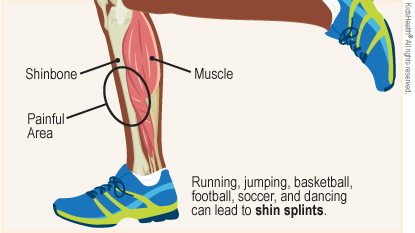Shin Splints: How to Care for Your Child
Shin splints are pain on the inner part of the shinbone. Shin splints usually happen in people who do high-impact activities or ones with frequent stops and starts, such as running, jumping, basketball, football, soccer, and dancing. Shin splints usually get better with rest and do not cause lasting problems.


People with shin splints need to cut down or avoid all activities that cause pain. Walking and non-weight-bearing exercises (like swimming or riding a bike) usually do not cause pain and can be continued.
Kids with shin splints often need to take a few weeks off from high-impact sports. Your child can gradually return to high-impact sports after being pain-free for 2 weeks. If the sport causes any pain, your child needs to stop the activity and take more time to heal.
To help with shin splints, the health care provider also may recommend:
-
Putting ice or a cold pack on the shin every 1–2 hours for 15 minutes at a time. (Put a thin towel over the skin to protect it from the cold.)
-
Giving medicine for pain such as ibuprofen (Advil®, Motrin®, or a store brand) or acetaminophen (Tylenol® or a store brand). Follow the directions that come with the medicine for how much to give and how often to give it.
-
Exercises to stretch and strengthen the foot/leg muscles and tendons.
-
Using an elastic wrap or compression stocking to help with pain and swelling.


What causes shin splints? The pain of shin splints is caused by irritation and swelling of the muscles, tendons, and bones in the lower leg.
Shin splints are an overuse injury. They happen because someone does the same movement over and over again (for example, running). They also can happen if a person makes a sudden change in an exercise routine, such as exercising more often or making the workouts more intense.
How can my child prevent shin splints from coming back? To help prevent shin splints from coming back, your child can:
-
wear shock-absorbing athletic shoes with arch support
-
replace athletic shoes that don't fit well or that are worn out
-
increase any exercise routine slowly
-
work with a trainer or coach to train safely
-
cross-train by doing different kinds of exercises on different days